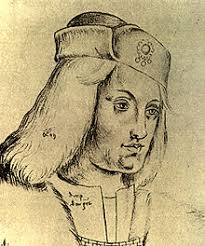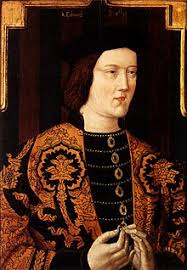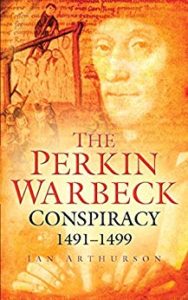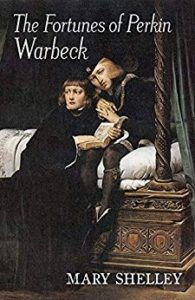Episode 124 of the Renaissance English History Podcast was on Perkin Warbeck
Books on Perkin Warbeck
Historical fiction:
A Song of Sixpence: The Story of Elizabeth of York and Perkin Warbeck
By Judith Arnopp - Buy on Amazon here
The Perkin Warbeck Conspiracy
By Ian Arthurson
Buy on Amazon here
The Fortunes of Perkin Warbeck
by Mary Shelley
Buy on Amazon here
The Likeness between Perkin Warbeck and Edward IV 

Renaissance English History Podcast Tudor Rebellions Series
Throwback Episode 052: Rebellions Part Two
Transcript of Episode 124: Perkin Warbeck
[advertisement insert here: if you like this show, and you want to support me and my work, the best thing you can do (and it’s free!) is to leave a rating or review on iTunes. It really helps others discover the podcast. Second best is to buy Tudor-themed gifts for all your loved ones at my shop, at TudorFair.com, like leggings with the Anne Boleyn portrait pattern on them, or boots with Elizabeth I portraits. Finally, you can also become a patron of this show for as little as $1/episode at Patreon.com/englandcast … And thank you!]
Hello and welcome to the Renaissance English History Podcast, a part of the Agora Podcast Network. I’m your host, Heather Teysko, and I’m a storyteller who makes history accessible because I believe it’s a pathway to understanding who we are, our place in the universe, and being more deeply in touch with our own humanity. This is Episode 124, a History’s Mystery on Perkin Warbeck.
So now, to Perkin Warbeck. I remember reading Alison Weir’s book on the Princes in the Tower way back around 1997, and over the years my understanding has deepend each time I read something new about them. Then, when I did the series on Tudor Rebellions a few years ago, I got caught up with him again, and then there was that Channel 4 documentary on him a few years ago, and basically, long story short, he and I have been orbiting around each other, and I thought it was time to do an episode devoted solely to him, and the forces at work with his rebellion.
The first thing is, it’s important to remember that we actually don’t know for sure what his name really was. The information we have about his childhood comes from a confession extracted through questionable circumstances before he was executed, and so much of it, including even his name, should be looked at skeptically. With that said, the information he gave on family and relatives does match up with birth and death records in Tournai, where he came from, and so it is at least reliable to that level.
But let’s back up and talk about the context of Perkin Warbeck. For those of you who might not be as familiar with his story, he was the second pretender to Henry VII, supported by Yorkists and others who wanted to wreak havoc on the new Tudor dynasty.
The first pretender was Lambert Simnel whose unfortunate claim was to be that of the Earl of Warwick, the son of the Duke of Clarence, and therefore the nephew to Edward IV and Richard III. I say unfortunate because the Earl of Warwick was at that time very much alive and in the custody of Henry Tudor, residing in the Tower of London. Thus, the real Earl of Warwick could be displayed. The entire thing ended with the Battle of Stoke in 1487, seen today as the final battle in the Wars of the Roses. Lambert Simnel himself wasn’t blamed for much, and he was treated well by Henry Tudor, becoming a spit boy in the kitchen, and then a falconer. He died around 1525. And for more on that, I would refer you to the Tudor Rebellions series, which I’ll include in the show notes for this episode at Englandcast.com/Perkin.
So we had Lambert Simnel as a backdrop to the idea of pretenders. Of course, where it went wrong for Simnel was the fact that the real Earl of Warwick was alive. But what if you could pretend to be someone who was dead? Or very much missing?
That’s where Perkin Warbeck bursts onto the scene, claiming to be Richard of Shrewsbury, the Duke of York, and Richard IV. In 1490 he appears at the court of Burgundy, ruled by Margaret of York, the Duchess of Burgundy, coincidentally the sister of Edward IV and Richard III. She claimed Perkin as her nephew, and minted coins in his name.
His story was that his brother Edward had been murdered, but he had been spared by the murderers because of his innocence, but he had been sworn to not reveal his true identity for a number of years. He said that from 1483 to 1490 he had lived in Europe, cared for by Yorkists, but when his main guardian, Sir Edward Brampton, left to go back to England, he could declare his true identity.
Edward Brampton is a curious person, the Governor of Guernsey, a knight, adventurer, ship commander and the godson and protégé of Edward IV. Born Duarte Brandão, he emigrated to England during the late 1450s. In order to be accepted at court, he converted to Catholic Christianity, with Edward IV sponsoring him. Upon his conversion he adopted the English name of Edward Brampton. He fought in the War of the Roses, including the Battle of Tewkesbury, and was eventually awarded the position of Governor of Guernsey. With the help of his wife Lady Margaret Brampton, he won favours in both the Portuguese and English royal courts and was knighted in August 1484 by Richard III.
Following the defeat of Richard III, Brampton left England for the court of Margaret of Burgundy, where he met Perkin Warbeck. In several popular books he’s depicted as the rescuer of Prince Richard, and this is apparently where that story comes from.
So back to Richard/Perkin. At this point we see Perkin gaining support at the court of the Yorkist supporter Margaret of Burgundy, who had a grudge against the Tudors for, you know, killing her brother and that messiness.
In 1491 Warbeck goes to Ireland, which is a hotbed of Yorkist support. The Irish had supported Lambert Simnel before, and Ireland had a history of supporting Yorkists in general since the original Richard Duke of York had been the governor there during the reign of Henry VI. One of the leading Yorkists in Ireland helped him take on the identity of Richard, but the Irish in general weren’t really looking to start a rebellion and so Perkin went back to Europe.
The French saw an opportunity to give Henry Tudor a headache, and in 1492 received Perkin to court, where he was welcomed by no less a figure than the King Charles VIII. Henry wasn’t going to let this slight stand, and he invaded France, landing at Calais, and laying seige to Bolougne. Eventually the French gave in and agreed to pay England 159,000 pounds, to expel Warbeck, and to not ever support a pretender or rebel again, in exchange for the French controlling Brittany.
Still, Warbeck had the support of Margaret of Burgundy, who gave him lessons in the Yorkist court, and prepped him to be received. Henry complained to the Duke of Burgundy, Philip of Hapsburg, about the fact that the Holy Roman Empire was harboring the pretender, and when his complaint was ignored, he put a trade embargo on Burgundy. Throughout European monarchs, Perkin was known as the Duke of York, and in 1493 he attended the funeral of the Holy Roman Emperor Frederick III, and was recognized as King Richard IV of England.
In England throughout this period many pro Yorkist leaders came out supporting Warbeck, including Sir William Stanley, and Sir Robert Clifford, who actually went to Europe and wrote letters home confirming that Warbeck was truly Richard. Henry had many of these supporters arrested and tried, and most of them were beheaded, though Robert Clifford turned on the other conspirators and named names in exchange for a pardon.
In July 1495 Perkin made his first landing in England, landing in Deal in Kent, and financed by Margaret. He clearly hoped that a popular uprising would happen, but instead the locals rallied for Henry, and the battle was over before Perkin even got off the boat. He retreated to Ireland where he found a bit of support, but not enough to jusify staying there, and instead he moved to Scotland.
James IV of Scotland was happy to have him because he was a valuable piece of leverage in an international chess game. This is right when Henry VII is negotiating Prince Arthur’s marriage with Spain, and James courted Spanish ambassadors whom he hoped would help him in some of his grudges against England.
James allowed Perkin to marry Lady Katherine Gordon, a cousin of the King, with the marriage celebrated in Edinburgh. James gave Perkin his clothing for the wedding, and he wore armor covered in purple silk. There was a huge tournament to celebrate the marriage, just like any international marriage between princes.
The biographer of James IV, Normal Macdougall says that this is actually evidence that the Scots didn’t believe that he truly was Richard - after all, a cousin to the king isn’t quite the same status that the King of England would expect in a marriage.
Whether the belief was sincere or not, by September 1496 James was getting ready to invade England with Perkin. He had a banner made for Warbeck as the Duke of York, and the event was recorded by John Ramsay of Balmain, describing it for Henry. He reported 60 German soldiers who arrived on two small boats to meet with Warbeck. He estimated that they had about four or five days of provisions by the time they reached England, and advised that the English could attack with just a small army.
On September 14 James and Perkin went to Holyrood Abbey to offer up prayers, and then crossed the Tweed at Coldstream where they hoped for support in Northumberland for Warbeck. That support never came, and so after going four miles into England with a royal banner, they left on September 25 when an English army came from Newcastle. The Spanish then suggested that as part of the marriage negotiations between England and Spain, a peace with Scotland should be included.
Less than a year later, James was tired of Warbeck being at his court, made peace with England, and hired a ship to return Perkin to Ireland in July 1497. After trying to lay siege to Waterford Ireland he was chased by English ships away, and was left with only about 120 men.
So how do we get from Ireland to the invasion of England? In 1497 there was a rebellion going on in Cornwall over taxes for war with Scotland that the Cornish weren’t too keen on. Warbeck arrived in Cornwall and said that he could stop the tax if only they would support his claim. And this they did, declaring him Richard IV, and allowing him to lead a Cornish army of 6,000 men who marched into Exeter in September. Henry sent troops to crush the Cornish, Perkin panicked and fled. He was captured at Beaulieu Abbey in Hampshire where he surrendered in October 1497. Warbeck was imprisoned, and paraded through the streets on horseback as a trophy.
He was treated well by Henry at first, in accordance with Henry’s habit of not punishing the pawns but going for the ringleaders instead. He confessed to being an imposter, and was given a room at Henry’s court where he was allowed to attend royal banquets. He was kept under guard, though, and was not allowed to sleep with his wife, who was living with the Queen during this time.
After 18 months of this sort of house arrest in a gilded cage, Warbeck tried to escape. He was quickly recaptured and was then sent to the Tower of London, first in solitary confinement, and then next to the aforementioned Earl of Warwick. Supposedly the two tried to escape in 1499, were recaptured, and executed.
With that said, this is the period when Ferdinand and Isabella are seeking assurance that Henry is secure on his throne, and want all obstacles to his reign out of the way before sending their daughter Katherine to England. So many people believe that the two may have been framed and goaded into escaping in order to justify hanging them. Warwick was beheaded since he was noble, but on 23 November 1499 Perkin Warbeck was hanged at Tyburn.
An interesting aside is that the biggest thing Perkin Warbeck had going for him was his appearance - in his one sketch drawing you can see a clear resemblance between Edward IV and Warbeck. And so, before they hung him, supposedly the guards beat him up to hide that appearance. There has been speculation that he might have been Edward’s illegitimate son, or some relation to the Yorkists, or even a relative of Margaret of York in some way.
There are some authors who believe that Perkin Warbeck was actually who he said he was - after all, how could a lowly Breton boy speak English so eloquently, and comport himself so well at court if he hadn’t been brought up in it? And it’s certainly possible that he was Richard, Duke of York. This is why it’s a history’s mystery. Most academics don’t give credence to that belief, and I’m not going to argue with them, but it certainly is a tantalizing idea that one of the Princes in the Tower was able to escape.
There are, of course, tons of books about Perkin Warbeck and the Princes in the Tower to choose from, but I’d send you to the works of Matthew Lewis for one view, and Alison Weir for another. He has fascinated writers for centuries, and even Mary Shelly, the author of Frankenstein, wrote a book about him. I’ll link to some of my favorites in the show notes at Englandcast.com/Perkin.
And you can get in touch with me through the listener support line at 801 6TEYSKO or through twitter @teysko or facebook.com/englandcast.
[advertisement insert here: if you like this show, and you want to support me and my work, the best thing you can do (and it’s free!) is to leave a rating or review on iTunes. It really helps others discover the podcast. Second best is to buy Tudor-themed gifts for all your loved ones at my shop, at TudorFair.com, like leggings with the Anne Boleyn portrait pattern on them, or boots with Elizabeth I portraits. Finally, you can also become a patron of this show for as little as $1/episode at Patreon.com/englandcast … And thank you!]



